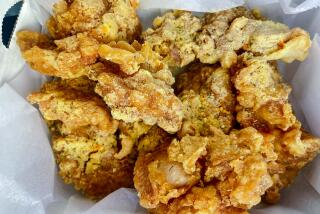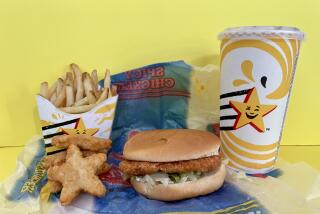Fast-Food Chains See a Big Future in Smaller Bites
- Share via
After years of offering bigger entrees with names like the Whopper and Chicken-On-a-Bun, some fast-food operators have become imitators of the thriving White Castle hamburger chain, which sells a tiny 32-cent burger in the East that’s achieved cult status.
Burger King, which has been trying to overhaul its image following ineffective marketing efforts, announced this week that its 1,200 outlets throughout the United States will begin offering mini-cheeseburgers it calls Burger Bundles.
Meanwhile, Kentucky Fried Chicken, in a bid to capture a bigger lunchtime trade, has launched a massive advertising campaign for its new 39-cent sandwich called Chicken Littles.
“I’m more flattered than I am concerned,” said William Krestel, assistant director of advertising for White Castle. “The reason people come to White Castle is not the price or size of the product but the unique taste of the product. If you are hungry for a White Castle burger, there’s only one place to get it.”
Until recently, little burgers generally could be found only in regional chains or local diners such as White Castle, the Little Tavern chain in the Washington and Baltimore area, the Chattanooga, Tenn.-based Krystal restaurants in the Southeast and White Tower restaurants operated by Tombrock Corp. of Stamford, Conn.
In the wake of the national response tapped by the “Where’s the Beef?” slogan of the Wendy’s hamburger chain, it seemed the tiny fast-food sandwiches would remain mostly a curiosity.
But Burger King and Kentucky Fried Chicken, which like much of the fast-food industry have been unable to maintain their rapid growth rates despite selling everything from salads to breakfast food, have seized upon the tiny edibles. Along with more recent bite-sized fast-food innovations such as chicken nuggets, chains say the popular tiny burgers are evidence that consumers want easily consumable, portable finger food rather than more expensive big sandwiches that might spill on their clothes.
Indeed, since its founding in 1921, Columbus, Ohio-based White Castle has racked up such impressive sales for its tiny, silver-dollar-sized hamburgers that bigger operators like Burger King and Kentucky Fried Chicken now think there may be more profit in selling a lot of inexpensive little sandwiches than in selling fewer higher-priced sandwiches.
White Castle operates only 225 restaurants in 13 Midwestern and Northeastern states, compared to more than 7,000 McDonald’s, 1,200 Burger King and 4,700 Kentucky Fried Chicken outlets. Yet it outperforms all of its fast-food rivals except McDonald’s. The average White Castle restaurant generates $1.3 million in revenue, compared to $1.37 million for No. 1 McDonald’s and $1.14 million for No. 3 Burger King.
“People are startled when you tell them that the per-store average volume of White Castle is about the same as McDonald’s,” Richard P. Mayer, chief executive of Kentucky Fried Chicken Corp., recently told a group of security analysts meeting in Louisville, Ky. “They don’t generate that $1.3-million-per-store average with a long list of products. They do it with one product--a small hamburger.”
For its part, Burger King does not acknowledge imitating White Castle’s mini-burger concept with its Burger Bundles, which come in three-packs and six-packs priced at $1.26 and $2.58, respectively.
“We’ve been looking at this product for a long time,” said Ann Kokenge, a Burger King spokeswoman. “White Castle is not the inspiration.
“Our market research shows that consumers were interested in snacking on a product that is fun and convenient. Burger Bundles is the most successful new product test in Burger King history.”
More to Read
Eat your way across L.A.
Get our weekly Tasting Notes newsletter for reviews, news and more.
You may occasionally receive promotional content from the Los Angeles Times.










